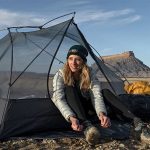Two years ago, Patagonias CEO Michael Crooke issued a challenge to the outdoor industry to become the leaders in environmental sustainability. Apparently the industry took this message to heart, because this years OR Winter Market was a showcase of innovative, eco-conscious ideas in footwear, apparel, and hardgoods. Nearly every vendor on the floor invested into the R&D of more environmentally-friendly design and development of their product line. The innovations varied from new organic, chemical-free wicking treatments, to new garment recycling programs, to glue-less shoe construction.
While the industry still has a long way to go, it is clear the environmental and social sustainability are taking a front seat in the continuous push towards newer and better products. At the same time, companies on the OR show floor are still able to push the boundaries of technical innovation and even lead the market in a few fashion trends.
OR Winter Market closed its doors as the most successful show to-date. The newly renovated Salt Palace with a larger floor plan hosted more vendors than ever before, and, this attracted more attendees and buyers. There were 815 exhibitors, including 274 new exhibitors and 152 expanded booth presentations. A record 17,973 total attendees visited OR Winter Market this year, up 24% from 2006. Buyer attendance was up 14% to 5,602.
Patagonia made headlines around the world with the announcement that they will be accepting all Polartec garments ever made into their polyester recycling program, which was created in conjunction with Teijin. This means that any of the millions of TNF Denali Jackets hanging in collegiate dorm closets, and the thousands of Cloudveil Gridlock Jackets and ArcTeryx Delta AR Jackets could be recycled into Patagonia products as early as next year. During its lifetime, Malden Mills has created enough Polartec fabric that, if recycled, it could make 300 million garments.
This program, which is an extension of last years Common Threads program, is part of Patagonias strategic goal of making their entire line recycled or recyclable by 2010. Currently about 30% of their products meet this criteria and 90% of their lifestyle product has an environmental story.
In addition, Patagonia will be accepting its own organic cotton for recycling as part of a partnership with the Italian textile company Calamai. This dramatic expansion of the Common Threads program offers several advantages. By recycling cotton, the company saves 20,000 gallons of water per KG of cotton produced and it reduces greenhouse emissions by 20%. By using existing garments to feed the polyester supply chain, Patagonia is reducing greenhouse gas emissions by 76%, including the transportation of the garments to Teijins factory in Japan.
Cloudveil came into the show with a considerable amount of momentum after an 87% increase in sales last year. The company will be celebrating its 10th anniversary this year and in honor of that, Cloudveil will be producing a special edition Serendipity jacket.
While rumors were swirling around the show floor concerning a future sale of the brand, Cloudveil management had no comment on the matter. The rumors were prompted by SBIs (Cloudveils parent company) recent sale of the Fila brand, but management said, “people can draw their own conclusions.” If the rumors are true, Cloudveil will certainly sell for a rather high premium, given the scarcity of authentic outdoor brands and the current high demand by both strategic and private equity investors.
Marmot showed off an expanded apparel line with depth in both technical and fashion styles. While stressing a commitment to its core high-performance offerings, there is no doubt that Marmots commitment to crossover (albeit highly technical) street-wear style is also growing. A company exec called the urban-performance styles “a direction we are headed in carefully.”
Silhouettes in the majority of Marmots outerwear are modern, clean and functional, with fewer pockets and a “less is more” approach. As far as new tech introductions in apparel, Marmot is the exclusive North American launch partner with W.L. Gore to offer a fully welded Gore-Tex shell jacket. Additionally, Marmot has a North American exclusive on Polartecs PowerDry baselayer with up-cycled Cocona performance technology.
Lafuma came to OR with their largest apparel collection in North America to date with 50 new styles. The company plans to continue to ramp up its offering with over 150 new styles planned for the summer show this year. The apparel line includes a technical offering as well as a lifestyle offering with casual down pieces and a womens full-length Gore-Tex trench coat. The company also will have their complete pack line re-designed for the summer show.
Lafuma has decided to move away from Gore-Tex in their footwear, in favor of OutDry a membrane that is laminated directly to the upper material. Rather than create a line of various pieces with eco-friendly materials and construction processes, Lafuma has created one item in every category with this story. This gives their designers a broad base of best-practices to learn from.
Millet, a subsidiary of Lafuma, is still focusing its efforts on a few elite retailers in the U.S. Instead of having a booth at OR, the brand invites these key accounts to France each year to see the line. Currently there are 50 retailers and the brand will slowly open more accounts each year, but it will stick to its elite specialty distribution strategy. This year, the brand will be selling to select premium on-line specialty outdoor retailers. Lafuma management said that the next brand they will bring to the U.S. will be Oxbow, but they do not have a time-line for this launch yet.
Westcomb has been making hybrid jackets and apparel for several years now, and the company run by designer Alan Yiu is continuing to develop this category. Their new Rampage jacket blends Schoeller Dynamic fabric with eVent to create a highly breathable, storm-worthy shell with the same properties as a soft shell. The brand is also looking at more lifestyle pieces that still function well in the high mountains. The new Pinnacle uses fine Italian wool to insulate, but is bar-friendly.
Loki announced that its Loki Mitt design has been recognized and protected by the U.S. patent and Trademark Office with a utility patent for its Loki Mitt design. Meanwhile, the European Patent Office issued acceptance for patents on both the LOKI Mitt & Loki Face Shield designs for the EU. The design niche that Loki has targeted is making the mitt and face shield a part of the jacket. The mitt and face shield tuck away, yet remain attached to the garment.
Loki founder Seth Anderson says that the brand is seeing a lot of growth in the Japanese market, and he envisions the application for the technology to be very broad across U.S. sporting goods retail. The incorporation of an attached mitt, for example, into a sweatshirt, is a utilitarian feature that is proving to have broad appeal, according to Andersen. At present, the privately held company has no plans to license the Loki innovation to other apparel manufacturers.
The North Face has doubled in size since it showed up for ORWM in 2001 by increasing its domestic and international distribution. While the company has been growing its door count considerably in international markets, the vast majority of its success in the U.S. has been due to increased volume through its existing retail partners, and a slight up-tick in owned-retail. Four years ago, TNF management decided to try and make the brand more accessible to more price conscious consumers with the introduction of its Khumbu fleece. However since 2004, the brand has been seeing its ASP climb at a steady rate.
TNF feels that they are now “on the map” as a performance endurance running brand. In the spring of 2008, the company will introduce a re-vamped footwear line that will be closer to the road running market and use more sustainable materials.
v
TNF has long been recognized as a leader in social awareness programs with their efforts in the Himalayas, but there has been a slight gap in environmental efforts. Going forward, TNF president of the Americas, Steve Rendle, said that the company will be looking at more eco apparel construction and “working to bring our environmental message up to the same level as our social message.” Currently, the company already has some unique programs, such as working with Conservation Funds “Go Zero” program, which offsets greenhouse gas emissions by reclaiming urban land and planting trees.
Hind continues to work to develop its lines successfully beyond simply core running. The brand has an eye on style and sustainability with the re-launch of its Pavement Optional collection, which is a technical lifestyle line that uses sustainable and durable fabrics. Wool and bamboo are used in the line, which aims to combine renewable resources with performance-packed alternative yarns.
Wool naturally absorbs and dissipates sweat, and acts as a temperature regulator. Bamboo offers anti-bacterial, highly absorbent and temperature-regulating technologies. Additionally, for spring 2008 Hind will unveil what it is calling the first ever triathlon-specific sports bra. The garment is quick-drying and is designed to offer support to not only runners, but cyclists and swimmers, as well.
Topo Ranch continues to expand their line, which started off as a simple offering of funky tees. With over 100 SKUs, the company is now offering their first fully-merchandised womens line. At the same time, they are moving their lines towards organic and sustainable fabrics, with 65% of their offering currently organic. The end goal is to have every piece telling some kind of sustainable story. While some smaller companies are having difficulty in sourcing organic cotton, Topo Ranchs management went straight to India to find a suitable factory that had the supply chain in-place. In addition, Topo Ranch has a partner in L.A. that has agreed to work with them on short-run organic cotton apparel manufacturing to fill ASAP orders.
Wool infused garments continue to be a growing trend, and were seen in products all over the show floor. Brands such as Icebreaker, SmartWool and Ibex have plenty of company now, as wool is making its mark in some less traditional areas as well.
Dale of Norway, best known for its wool ski sweaters, launched a technical and fashionable version of a wool softshell jacket that the brand is calling “Knitshell.” Developed in collaboration with W.L. Gore, the new Knitshell jacket combines Dale of Norways proprietary water resistant yarn and a new technology that allows Gores traditional Windstopper membrane to be adhered to wool. The result is a jacket that repels water and offers wind protection. The garments are being offered in a vest and jacket style. Additionally, Dale of Norway reports that it saw such strong reaction to its Merino wool base layer launch last winter that the 2007 collection is being expanded.
Timberlands outerwear offerings are following a universal approach, and are being designed for on-or-off mountain use. New technology in Timberlands outerwear includes the use of higher-end RiRi zippers, along with welded seams on its down pieces. Not surprisingly, Timberland also continues to leverage its SmartWool brand, incorporating SmartWool technology into Timberland outerwear with both fashionable and technical touches.
SmartWool continues to be used by Timberland as a “component” in place of fleece in some of the Fall 2007 Timberland outerwear pieces, and is also being incorporated via body mapping insulation in a few of Timberlands new jackets. Last year, TBL had roughly eight SKUs in their womens line, but now there is a full line of both mens and womens apparel.
Timberland is expanding their apparel line even as the company transforms itself into an environmentally-friendly holding company, giving authentic eco-friendly brands the capital and infrastructure needed to expand beyond the start-up phase. In addition, the company showed up at OR this year with a new booth made of 98% repurposed materials by re-using shipping containers and recycled materials.
Filson is now under new leadership, with 26-year Patagonia vet Bill Kulczycki serving as president and CEO. Kulczycki said that he wanted to be careful not to “Patagonia-ize” Filson, but he would be exploring ways for the brand to leave less of a footprint with its manufacturing and product development. The company will be pursuing an owned retail strategy, with two stores currently open and an additional six to seven scheduled for opening in the next five years. Currently, the company is busy working on a brand audit and the next generation of products.
Lifestyle Brands With a Climbing Heritage Move Ahead…
Static Mountain had a larger presence in the climbing area of the show than they had at previous shows. The six-year-old company has been specializing in climbing and yoga apparel with bamboo as a key material throughout much of the line. SMC is seeing its business shift slightly, with its custom-printed bamboo tees taking up more sales than ever before.
Blurr is also continuing to ramp up its organic offering with every new style made out of organic cotton. They have also created one of the only all organic moisture management fabrics that uses no chemicals. On the hardgoods side, the company has greatly expanded its travel line, with several new models.
prAna continues to be in a class by itself when it comes to climbing lifestyle apparel. The company more than doubled the size of its wind power initiative and added all of its U.S.-based factories to the program. prAna still manufactures the majority of its line domestically. In addition, the company launched two insulated outerwear pieces at the show, a mens jacket and a womens jacket. Each one uses Hemp and PET in their construction and has a distinct prAna style.
Gramicci has segmented their line into four distinct categories R82, the 1982 revival styles; Built for Sport, the performance adventure travel and backcountry line; The Lifestyle Collection; and Greenicci, the eco-friendly collection that is using hemp, organic cotton, and PET. Marty Weening, the president of Gramicci, said that the first season allowed his designers and product developers to learn a lot about the nature of their customer. If anything, they under-estimated demand for their core, heritage product that is the reason behind the creation of the R82 line. The big story out of the company is that the new management team was able to re-design the line while at the same time getting the operation ship on the right course. Gramicci was able to ship “in the 90% plus range” on-time and complete this year. Going forward, the company is focusing on training its retailers in techniques to increase inventory turns by ordering product in smaller shipments and more often.
Editors Note: Next week, The B.O.S.S. Report will continue with SIA.07 and OR Winter Market show coverage focusing on snowboard equipment & apparel, hardgoods, and footwear…















